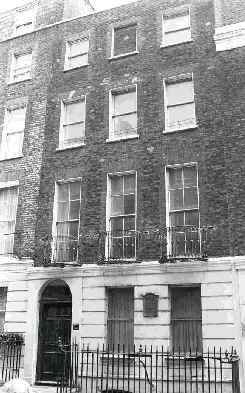Milestones:Benjamin Franklin's work in London, 1757-1775: Difference between revisions
No edit summary |
No edit summary |
||
| (12 intermediate revisions by 4 users not shown) | |||
| Line 1: | Line 1: | ||
[[Image:Benjamin Franklin's Work in London.jpg|thumb]] ''[[Benjamin Franklin|Benjamin Franklin]], American electrician, printer, and diplomat, spent many years on Craven Street. He lived at No. 7 between 1772 and 1775 and at No. 36 from 1757-1762 and again from 1764-1772. During these years, Franklin popularized the study of electricity, performed experiments, and served as an advisor on lightning conductors.'' | |||
'''The plaque may be viewed at the Franklin house museum at 36 Craven St, London, England.''' | |||
Franklin, considered one of the founders of modern Physics, was already a famous scientist when he arrived at Craven Street in 1757. He resided there for 16 years. | Franklin, considered one of the founders of modern Physics, was already a famous scientist when he arrived at Craven Street in 1757. He resided there for 16 years. | ||
In the room behind his parlor, Franklin constructed a laboratory for his research. Here he continued his electrical experiments. He proved that electricity has a positive and a negative charge, invented an improved generator and storage batteries. Franklin had proved that lightning is electrical. He had flown metal-tipped kites during thunderstorms and "captured the fire of heaven". He continued these experiments, sending kites aloft along the Thames during thunderstorms. By experimenting with different metals and shapes he was able to perfect his famous lightning rod conductor. This was such a success that Lightning Rods were placed on St. James's Palace (greatly to the annoyance of George III) and on the other great State buildings, churches and cathedrals in London. | In the room behind his parlor, Franklin constructed a laboratory for his research. Here he continued his electrical experiments. He proved that electricity has a positive and a negative charge, invented an improved generator and storage batteries. Franklin had proved that lightning is electrical. He had flown metal-tipped kites during thunderstorms and "captured the fire of heaven". He continued these experiments, sending kites aloft along the Thames during thunderstorms. By experimenting with different metals and shapes he was able to perfect his famous [[Lightning Rod|lightning rod]] conductor. This was such a success that Lightning Rods were placed on St. James's Palace (greatly to the annoyance of George III) and on the other great State buildings, churches and cathedrals in London. | ||
At Craven Street, Franklin perfected his famous Stove, which is still in wide use today. It burns its own smoke and saves fuel. | At Craven Street, Franklin perfected his famous Stove, which is still in wide use today. It burns its own smoke and saves fuel. | ||
During a hot London summer Franklin invented the Air Bath, the forerunner of Air Conditioning. | During a hot London summer Franklin invented the Air Bath, the forerunner of Air Conditioning. | ||
51.50749, -0.124899, | <div class="header"><span class="head1">INNOVATION</span><span class="head2"> MAP</span></div><!-- Franklin --> | ||
<googlemap controls="small" height="250" width="300" zoom="13" lon="-0.124899" lat="51.50749" version="0.9"> | |||
51.50749, -0.124899, | |||
Benjamin Franklin's work in London, 1757-1775 | |||
36 Craven Street, London, England | 36 Craven Street, London, England | ||
</googlemap> | </googlemap> | ||
[[Category: | [[Category:Fields, waves & electromagnetics|Franklin]] [[Category:Electricity|Franklin]] | ||
Revision as of 13:45, 4 April 2012
Benjamin Franklin, American electrician, printer, and diplomat, spent many years on Craven Street. He lived at No. 7 between 1772 and 1775 and at No. 36 from 1757-1762 and again from 1764-1772. During these years, Franklin popularized the study of electricity, performed experiments, and served as an advisor on lightning conductors.
The plaque may be viewed at the Franklin house museum at 36 Craven St, London, England.
Franklin, considered one of the founders of modern Physics, was already a famous scientist when he arrived at Craven Street in 1757. He resided there for 16 years.
In the room behind his parlor, Franklin constructed a laboratory for his research. Here he continued his electrical experiments. He proved that electricity has a positive and a negative charge, invented an improved generator and storage batteries. Franklin had proved that lightning is electrical. He had flown metal-tipped kites during thunderstorms and "captured the fire of heaven". He continued these experiments, sending kites aloft along the Thames during thunderstorms. By experimenting with different metals and shapes he was able to perfect his famous lightning rod conductor. This was such a success that Lightning Rods were placed on St. James's Palace (greatly to the annoyance of George III) and on the other great State buildings, churches and cathedrals in London.
At Craven Street, Franklin perfected his famous Stove, which is still in wide use today. It burns its own smoke and saves fuel.
During a hot London summer Franklin invented the Air Bath, the forerunner of Air Conditioning.
<googlemap controls="small" height="250" width="300" zoom="13" lon="-0.124899" lat="51.50749" version="0.9"> 51.50749, -0.124899, Benjamin Franklin's work in London, 1757-1775 36 Craven Street, London, England </googlemap>
